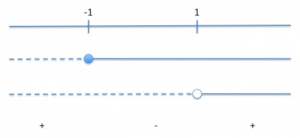Semplifica la seguente espressione:
[math][/math]\biggl( \sqrt[3]{(x + 1) \sqrt{frac{1}{x^2 - 1}}} : \sqrt{frac{x + 1}{x - 1}} \biggl) * \sqrt{\sqrt[3]{frac{x + 1}{x - 1}}} [math][/math]
Svolgimento
Cominciamo ponendo le condizioni di esistenza;
[math][/math]
left{
egin{array}{ll}
frac{1}{x^2 - 1} ⥠0&\
frac{x + 1}{x - 1} ⥠0&\
sqrt[3]{frac{x + 1}{x - 1}} ⥠0 &
end{array}
ight.
[math][/math]
Risolviamo la prima disequazione:
[math]frac(1)(x^2 - 1) ⥠0 [/math]
[math] N ⥠0 \to 1 ⥠0 â x ââ [/math]
[math] D > 0 \to x^2 - 1 > 0 [/math]
Risolviamo questa disequazione prendendo come soluzioni gli intervalli esterni alle radici dell'equazione associata:
[math] x^2 - 1 = 0 \to x^2 = 1 \to x = ± 1 [/math]
Si ha quindi:
[math] x > - 1 ⨠x > 1[/math]
Passiamo alla seconda disequazione:
[math] frac(x + 1)(x - 1) ⥠0 [/math]
[math] N ⥠0 \to x + 1 ⥠0 \to x ⥠- 1[/math]
[math] D > 0 \to x - 1 > 0 \to x > 1 [/math]
Studiamo il segno e prendiamo come soluzioni gli intervalli positivi:

[math] x ⤠- 1 ⨠x > 1 [/math]
Passiamo alla terza disequazione:
[math][/math] \sqrt[3]{frac{x + 1}{x - 1}} ⥠0 [math][/math]
Affinché una radice cubica sia maggiore o uguale a zero, è necessario che lo sia il suo radicando:
[math] frac(x + 1)(x - 1) ⥠0 [/math]
Questa disequazione, però, è identica alla precedente; possiamo quindi scrivere direttamente le soluzioni:
[math] x ⤠- 1 ⨠x > 1 [/math]
Il sistema sarà quindi
[math][/math]
left{
egin{array}{ll}
x 1&\
x ⤠- 1 ⨠x > 1 &\
x ⤠- 1 ⨠x > 1 &
end{array}
ight.
[math][/math]
Si ottiene:
[math] x > - 1 ⨠x > 1 [/math]
Procediamo alla semplificazione dell'espressione:
[math][/math]\biggl( \sqrt[3]{(x + 1) \sqrt{frac{1}{x^2 - 1}}} : \sqrt{frac{x + 1}{x - 1}}\biggl) * \sqrt{\sqrt[3]{frac{x + 1}{x - 1}}} [math][/math]
Non sapendo il segno di
[math]x+1[/math]
, dobbiamo studiare il segno della disequazione
[math] x + 1 ⥠0 [/math]
tenendo conto delle condizioni di esistenza:

Procediamo, quindi, distinguendo i due casi:
Caso
[math] x + 1 ⥠0 [/math]
[math][/math]\biggl(\sqrt[3]{(x + 1) \sqrt{frac{1}{x^2 - 1}}} : \sqrt{frac{x + 1}{x - 1}}\biggl) * \sqrt{\sqrt[3]{frac{x + 1}{x - 1}}} = [math][/math]
[math][/math]\biggl(\sqrt[3]{ \sqrt{frac{(x + 1)^2}{(x + 1)(x- 1)}}} : \sqrt{frac{x + 1}{x - 1}}\biggl) * \sqrt{\sqrt[3]{frac{x + 1}{x - 1}}} = [math][/math]
[math][/math]\biggl(\sqrt[3]{ \sqrt{frac{x + 1}{x- 1}}} : \sqrt{frac{x + 1}{x - 1}}\biggl) * \sqrt{\sqrt[3]{frac{x + 1}{x - 1}}} = [math][/math]
Moltiplichiamo gli indici delle radici:
[math][/math]\biggl(\sqrt[6]{frac{x + 1}{x- 1}} : \sqrt{frac{x + 1}{x - 1}}\biggl) * \sqrt[6]{frac{x + 1}{x - 1}} = [math][/math]
Riduciamo le radici all'interno della parentesi tonda allo stesso indice:
[math][/math]\biggl( \sqrt[6]{frac{x + 1}{x- 1}} : \sqrt[6]{\biggl(frac{x + 1}{x - 1}\biggr) ^3}\biggl) * \sqrt[6]{frac{x + 1}{x - 1}} = [math][/math]
[math][/math]\biggl( \sqrt[6]{frac{x + 1}{x- 1}} : \sqrt[6]{frac{(x + 1)^3}{(x - 1)^3}} \biggl) * \sqrt[6]{frac{x + 1}{x - 1}} = [math][/math]
Portiamo sotto un'unica radice ed effettuiamo la divisione:
[math][/math]\biggl( \sqrt[6]{frac{x + 1}{x- 1} : frac{(x + 1)^3}{(x - 1)^3}} \biggl) * \sqrt[6]{frac{x + 1}{x - 1}} = [math][/math]
[math][/math]\biggl( \sqrt[6]{frac{x + 1}{x- 1} * frac{(x - 1)^3}{(x + 1)^3}} \biggl) * \sqrt[6]{frac{x + 1}{x - 1}} = [math][/math]
[math][/math] \sqrt[6]{frac{(x - 2)^2}{(x + 1)^2}} * \sqrt[6]{frac{x + 1}{x - 1}} = [math][/math]
Allo stesso modo, svolgiamo la moltiplicazione:
[math][/math]\sqrt[6]{frac{(x - 1)^2}{(x + 1)^2} * frac{x + 1}{x - 1}} = [math][/math]
[math][/math]\sqrt[6]{frac{x - 1}{x + 1}} [math][/math]
Caso
[math] x + 1 > 0 [/math]
[math][/math]\biggl( \sqrt[3]{(x + 1) \sqrt{frac{1}{x^2 - 1}}} : \sqrt{frac{x + 1}{x - 1}} \biggr) * \sqrt{\sqrt[3]{frac{x + 1}{x - 1}}} = [math][/math]
[math][/math]\biggl( \sqrt[3]{- \sqrt{frac{(x + 1)^2}{x^2 - 1}}} : \sqrt{frac{x + 1}{x - 1}} \biggr) * \sqrt{\sqrt[3]{frac{x + 1}{x - 1}}} = [math][/math]
[math][/math]\biggl( \sqrt[3]{ - \sqrt{frac{(x + 1)^2}{(x + 1)(x- 1)}}} : \sqrt{frac{x + 1}{x - 1}} \biggr) * \sqrt{\sqrt[3]{frac{x + 1}{x - 1}}} = [math][/math]
[math][/math]\biggl( \sqrt[3]{ -\sqrt{frac{x + 1}{x- 1}}} : \sqrt{frac{x + 1}{x - 1}} \biggr) * \sqrt{\sqrt[3]{frac{x + 1}{x - 1}}} = [math][/math]
Possiamo portare il meno fuori dalla radice cubica:
[math][/math]\biggl( - \sqrt[3]{\sqrt{frac{x + 1}{x- 1}}} : \sqrt{frac{x + 1}{x - 1}} \biggr) * \sqrt{\sqrt[3]{frac{x + 1}{x - 1}}} = [math][/math]
Moltiplichiamo gli indici delle radici:
[math][/math] \biggl( - \sqrt[6]{frac{x + 1}{x- 1}} : \sqrt{frac{x + 1}{x - 1}} \biggr) * \sqrt[6]{frac{x + 1}{x - 1}} = [math][/math]
Riduciamo le radici all'interno della parentesi tonda allo stesso indice:
[math][/math] \biggl( - \sqrt[6]{frac{x + 1}{x- 1}} : \sqrt[6]{ \biggl( frac{x + 1}{x - 1} \biggr)^3} \biggr) * \sqrt[6]{frac{x + 1}{x - 1}} = [math][/math]
[math][/math] \biggl( - \sqrt[6]{frac{x + 1}{x- 1}} : \sqrt[6]{frac{(x + 1)^3}{(x - 1)^3}}\biggr) * \sqrt[6]{frac{x + 1}{x - 1}} = [math][/math]
Portiamo sotto un'unica radice ed effettuiamo la divisione:
[math][/math] \biggl( - \sqrt[6]{frac{x + 1}{x- 1} : frac{(x + 1)^3}{(x - 1)^3}} \biggr) * \sqrt[6]{frac{x + 1}{x - 1}} = [math][/math]
[math][/math] \biggl( - \sqrt[6]{frac{x + 1}{x- 1} * frac{(x - 1)^3}{(x + 1)^3}} \biggr) * \sqrt[6]{frac{x + 1}{x - 1}} = [math][/math]
[math][/math] - \sqrt[6]{frac{(x - 2)^2}{(x + 1)^2}} * \sqrt[6]{frac{x + 1}{x - 1}} = [math][/math]
Allo stesso modo, svolgiamo la moltiplicazione:
[math][/math] - \sqrt[6]{frac{(x - 1)^2}{(x + 1)^2} * frac{x + 1}{x - 1}} = [math][/math]
[math][/math] - \sqrt[6]{frac{x - 1}{x + 1}} [math][/math]









 Accedi a tutti gli appunti
Accedi a tutti gli appunti
 Tutor AI: studia meglio e in meno tempo
Tutor AI: studia meglio e in meno tempo